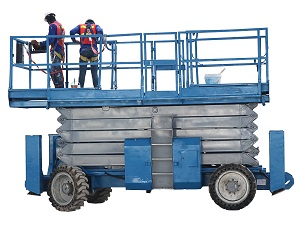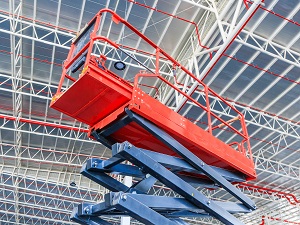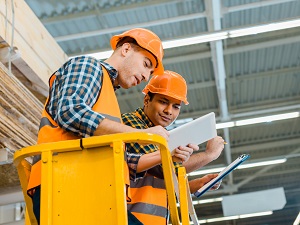Scissor lifts can pose serious risks to workers if they are not operated properly and safely. Although certain safety precautions apply to most scissor lifts, each lift has different weight limits, specifications and hazard warnings.

Workers will often use a scissor lift instead of assembling a stationary (non-mobile) scaffolding system if the platform will not be needed for long periods of time or if it will be used in many different work locations on one project.
Scissor lifts are considered mobile scaffolding. OSHA defines a mobile scaffold as a powered or unpowered, portable, caster or wheel-mounted supported scaffold.
Scissor lifts are not the same as aerial lifts. Scissor lifts have a lifting mechanism that moves the work platform straight up and down using crossed beams functioning in a scissor-like fashion rather than the extensible boom, articulating arms and rotating platforms found on aerial lifts.
Workers must follow all manufacturer guidelines for the safe operation of the scissor lift they are using on the job. Injuries and fatalities have occurred when safety precautions covering fall protection, stabilization, and positioning of the scissor lift are not addressed.

Workers must be trained to operate a scissor lift and must demonstrate to their employer that they can use a scissor lift safely. Never operate a scissor lift unless you have been trained on the operation of the lift! Become familiar with the specific scissor lift being used and the manufacturer’s guidelines before operating. Always follow guidelines specific to the type of scissor lift being used.
OSHA Standard 1926.454(a) The employer shall have each employee who performs work while on a scaffold trained by a person qualified in the subject matter to recognize the hazards associated with the type of scaffold being used and to understand the procedures to control or minimize those hazards…
Never exceed the rated load capacity of the scissor lift as provided by the manufacturer.
Select work locations that do not approach power sources, like overhead power lines, by at least 10 feet and that do not pose other overhead hazards. For scissor lift work that is near an electrical source, workers must be qualified with required electrical safety training.

Tip overs can occur if proper safety precautions are not followed when using scissor lifts. Ensure the ground a scissor lift is traveling or positioned on is free from bumps, holes, depressions, slick or wet surfaces, inclines and slopes.
Outriggers are used when stability is required. If work with a scissor lift must be completed while positioned on uneven ground, an incline, or a slope, ensure that the scissor lift is equipped with outriggers. Avoid operating scissor lifts in high winds. Consider waiting until winds calm down before proceeding with operations. When in a stationary position, the scissor lift wheels must be locked in place.
OSHA Standard 1926.452(w)(2) Scaffold casters and wheels shall be locked with positive wheel and/or wheel and swivel locks, or equivalent means, to prevent movement of the scaffold while the scaffold is used in a stationary manner.

Workers risk falling from a scissor lift if safety precautions are overlooked or not followed. It is important to follow scissor lift safety measures to prevent falls.
- Never lean over or out of the scissor lift platform basket. Keep work within easy reach to avoid leaning away from the lift.
- Never stand on, step up on, or step over the guardrail components of a scissor lift. Always keep both feet firmly planted on the platform of the scissor lift.
- Never climb up the scissor lift mechanism to reach the platform basket of the scissor lift.
- Before a scissor lift is moved, workers on the lift must be made aware of the travel and movement.
Prevent caught-in and crushed-by injuries and incidents when a scissor lift is in operation.
- Always ensure workers’ hands, legs, clothing and personal equipment are free from the scissor lift’s lifting mechanism when it is being operated.
- Implement traffic control measures around the scissor lift to prevent other workers or vehicles from getting too close.

Inspections and maintenance to scissor lifts are an important part of hazard prevention. Competent workers should perform these checks on scissor lifts each work shift before using:
- Check hydraulics for leaks.
- Check horns and alarms to ensure they are audible and working.
- Check wheels/tires for gouges, protruding objects or defects.
- Check all controls to ensure upper and lower controls on scissor lifts are in proper working condition.
- Check brakes and verify that once set the brakes will hold the scissor lift in position.
- Check gate to ensure that it securely latches and closes each time without force or manipulation.
- Check basket to ensure it is free from protrusions or holes bigger than 2” x 2” on the platform.
- Check hoses and lines for cracks, kinks, or corrosion.
If a scissor lift is found damaged it shall be removed from service until repaired.
OSHA Standard 1926.451(f)(3) Scaffolds and scaffold components shall be inspected for visible defects by a competent person before each work shift, and after any occurrence which could affect a scaffold's structural integrity.

.jpeg)

.jpg)